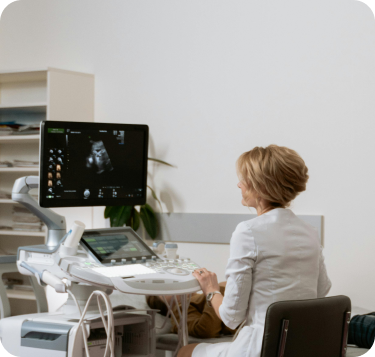

3D/ 4D/5D Ultrasound, Digital X-ray Investigations and Laboratory services.
The homely, state of art premium Ultrasound centre where imaging is done by using latest, modern 3D/4D/5D Ultrasound machines which provide ultimate joy to expecting women eyes by showing their babies movements.
Read More
X-rays are electromagnetic radiation that can penetrate tissues to create images of bones and some organs
uring imaging, the patient is positioned appropriately, and the imaging equipment is adjusted based on the modality
Radiologists compile their findings into detailed reports, which are then shared with referring physicians.
X-rays are electromagnetic radiation that can penetrate tissues to create images of bones and some organs
uring imaging, the patient is positioned appropriately, and the imaging equipment is adjusted based on the modality
Radiologists compile their findings into detailed reports, which are then shared with referring physicians.

Diagnotree uses the most advanced, versatile and trusted brands (G.E. Logiq F8 and Samsung HS70) ultrasound machines to scan the body parts.
Digital x-rays are the cutting edge in advanced x-ray technology. We have futuristic and advanced high definition digital x-ray machines (Allengers) in our centres that provide less exposure to the patients.


Diagnotree has a fully equipped laboratory with the latest equipment from leading global laborartory service providers (SRL).
Laboratory investigations, also known as laboratory tests or diagnostics, are an essential component of healthcare used to diagnose, monitor, and manage various medical conditions. These investigations involve the analysis of biological samples such as blood, urine, tissue, and other bodily fluids.
It is a long established fact that a reader will be distracted by the readable content of a page when looking at its layout. The point of using Lorem Ipsum is that it has a more-or-less normal distribution of letters, as opposed to using ‘Content here, content here’, making it look like readable English. Many desktop publishing packages and web page editors now use Lorem Ipsum as their default model text, and a search for ‘lorem ipsum’ will uncover many web sites still in their infancy. Various versions have evolved over the years, sometimes by accident,
There are many variations of passages of Lorem Ipsum available, but the majority have suffered alteration in some form, by injected humour, or randomised words which don’t look even slightly believable. If you are going to use a passage of Lorem Ipsum, you need to be sure there isn’t anything embarrassing hidden in the middle of text. All the Lorem Ipsum generators on the Internet tend to repeat predefined chunks as necessary, making this the first true generator on the Internet. It uses a dictionary of over 200 Latin words, combined with a handful of model sentence structures, to generate Lorem Ipsum which looks reasonable. The generated Lorem Ipsum is therefore always free from repetition, injected humour, or non-characteristic words etc.